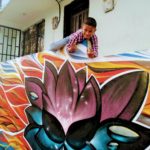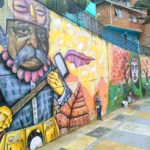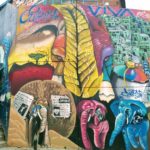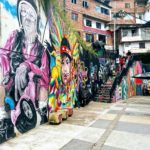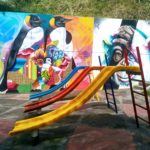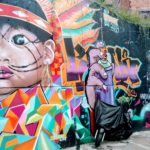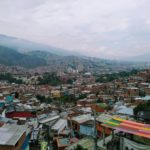Medellin: From Most Dangerous to Most Innovative City
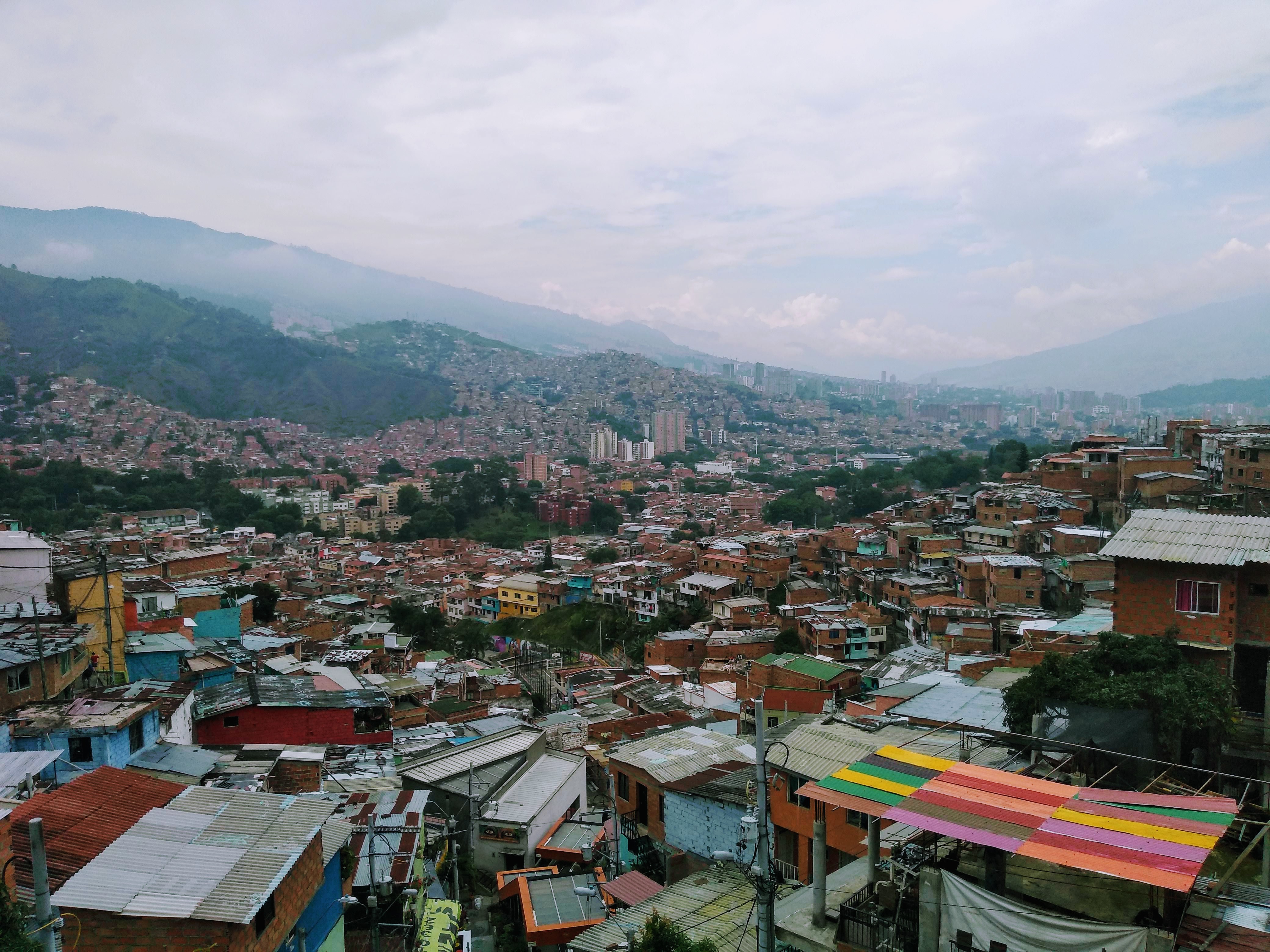
Today marks a month since I arrived back in Mexico after my long-awaited trip to Colombia. I started my journey feeling conflicted about my blogging: I wanted to document my trip day by day for you all to follow, but at the same time I didn’t want to miss out on my trip while I was on it. The blogging, photo organising and work I needed to maintain saw me taking every third day off to stay in my hostel or hole up in a cafe to work. So after my last post in Santa Marta, I decided to close my computer for the rest of my time and enjoy the journey I was on, with both eyes open and both hands liberated of my phone. I dropped contact with almost everyone in my regular daily routine and left my phone locked away in my hostel locker from Medellin to Bogota.
This now means I have a month of blogging to catch up on, which means a blitz of at least 4 or 5 posts, describing the rest of my time in Colombia – first up: Medellin.
Medellin – the city of constant springtime. A city where you never feel hot nor cold and the sun is always creeping out behind a blanket of clouds in an overcast sky. This booming metropolis reminded me of my beloved Melbourne for many reasons: the green parks, urban street-art vibe and the overpriced hipster cafes full of self-proclaimed “digital nomads”. It’s the number one place for expats to come and work in Colombia, and I heard many-a-local grumble about foreigners taking their jobs, a mindset that even reminded me of Australia too. Even the over-priced breakfasts and $6 coffees in the hipster neighbourhood Poblano, where all the foreigners stay in hostels and boutique hotels.
He who we do not speak of
There is, however, another reason people come to Medellin: to find out more about the life, death and ongoing ideological conflict of Colombia’s worst drug trafficker: Pablo Escobar. The subject of Escobar-related tourism is a taboo one, as many operators, even some of Escobar’s previous colleagues and family members, take advantage of the monstrosities that he committed to profit off curious and ignorant foreigners like me. I had made the decision years ago to not involve myself in any Netflix or TV drama that heroized a drug lord turned terrorist. So when I arrived in Medellin, I knew nothing, and I wanted to hear the story from a local who would not Hollywoodize the story. I joined a City Transformation Tour from my hostel and was pleased to be the last in the van, leaving me no choice but to sit up front with our guide. He took us through the streets of central Medellin, telling us chronologically of the various political assassinations that Escobar ordered to secure his position in the Senate and stop the extradition of drug traffickers to the US. We passed by a now-empty lot, which only a month earlier was his city house that had been demolished by the government. We also stopped in front of the land where once stood the building where Escobar was found and fatally shot. By whom? Officially, they say the police, but there are various theories about other drug lords, the Cali Cartel who the Medellin Cartel fought with for years, US agencies and various other criminal underlords that wanted a piece of the Escobar pie. After too much media attention and trespasser trying to look for evidence after his death, the owner of the building demolished it, but the fence still stands, with the inmate number that Escobar was holding in his infamous smiling mug-shot photo when he was arrested early in his career for possession of cocaine.
We went to his family’s grave-site, where a taxi driver who is the spitting image of Escobar was standing and charging a fee to take photos with him. I took a photo at Escobar’s tombstone but was later warned not to post it on social media, as many Colombians would not be pleased that yet another tourist was spending money to hear about a man that was responsible for thousands of deaths and some of the darkest times the city has seen. I noticed that our guide stayed away from the tombstone, and I picked up in our conversation that he did not like this part of the tour for the same reason, he used it as an opportunity to educate people about the true nature of Escobar.
Why is this such a contentious issue? Because there are still some poorer neighbourhoods in the city that benefited from the funds Escobar donated to construct schools, facilities and programs to improve the quality of life. What our guide reminded us of was that he never did this out of the goodness of his heart for the community – it was yet another political move to gain the vote of the masses. He was only blocks away from one of Escobar’s car bombs, which destroyed his parent’s house and killed 17.
One thing that people don’t know is that at this very site where flowers are still being laid at the Escobar family’s grave, also lies a far less-known character to the western world, but just as responsible for the beginnings of Escobar’s reign of death: Ms Griselda Blanco. The “Cocaine Godmother” was Pablo Escobar’s mentor of sorts, Colombian by birth but living in Miami, where she partnered with her young protegee to export cocaine to the US, teaching Escobar everything he came to know about drug trafficking in the US and personally responsible for killing thousands of people. She survived long after Escobar’s death until she was gunned down in a grocery store when she was back visiting Colombia only 7 years ago in 2012.
Comuna 13: A story of transformation and resilience
The biggest misconception I carried before arriving in Medellin was that the majority of violence and murders stopped after Escobar’s death in 1993. Paramilitary groups and guerillas (freedom fighters) loyal to Escobar fought with local gangs and other cartels trying to overtake the monopoly that the drug lord had left in his wake. Our next stop in one of the most densely populated barrios educated the hell out of me. Barrio is a word for a poor community, and Comuna Trece (District 13) is one of the worst-affected neighbourhoods from violence, once named the world’s most dangerous town for its staggering homicide rate. Situated high in the hills of Medellin, often called Favelas, Comuna 13 provided the perfect vantage point for these groups to maintain their hold on the district, staving off any military intervention while having ideal access to the highway to transport drugs and weapons. Up until only several years ago, not even the police would enter the area, and now it is home to up to 1000 tourists a day. The houses are brick shacks built in stacks atop of each other, living the hills as far as the eye can see. The summits of the mountains were once used by indigenous tribes to pray to their gods and it was eerie to imagine heavily-armed forces atop these peaks, staring down the barrel of a gun waiting to shoot on sight whoever attempted to enter from the only entry point of the district.
- The kids of the community were so friendly and always smiling for photos
- Graffiti art in Comuna 13, an initiative to keep kids off the streets out of gangs and giving them freedom to express themselves using art
- A lot of elephants are pictured in their street art. Elephants never forget.
- Incredible street art is created, then painted over to start all over again.
- 3 children lost their lives in the 2002 military strike against rebel groups in Comuna 13.
- Never forgetting both the indigenous and African origins of its people.
In 2002, the Colombian military carried out the controversial Operation Orion strike against the rebel forces on the densely populated town of 100,000 people, over 1000 police, soldiers and aircrew in helicopters assaulted the town, killing nine people (3 children), wounding hundreds, making medical treatment impossible, and leaving thousands displaced without homes. The town took to the street flying white flags, which was the beginning of the end of the fighting. Now as the district recovers slowly, there is a different vibe in the air as the locals now feel free to walk the streets. Young people take to creating hip hop music, break dancing and street art as a means of expression and activity to avoid joining street gangs or getting involved with drugs. The community funds street art projects and now the town is one of the best-known graffiti art hubs in the world. Local government has funded library projects, green zones for children, women’s outreach programs and, of huge significance to the area, the 6-level escalator that connects the highly-situated hill town to the lower levels of Medellin, making them feel more connected to their city and able to travel within 6 minutes what was once a 35 minute hike. Street vendors stop to chat with you as you sample the local beers and empanadas, the children run past and smile widely for photos, and are proud to explain the meanings within the graffiti art, of which there are over 300 within the district. Comuna 13 has a horrific history, but I left this town with a sense of hope and pride for the transformation that they are undergoing.
From Murder capital to Innovation capital
I continued to feel this sense of transformation for the rest of my time in Medellin. If history sparks your interest as much as mine, head to the Museo Casa de la Memoria (Museum House of Memory), which outlines in great detail the violent history of the state of Antioquia in the form of newspapers, interviews and music. My amazingly friendly uber driver on the way to the Museum, Sara, told me about how the cable car and newly-constructed metro train line have been amazing innovations that have seen incredible advances in the development of the city. Many large world organisations, including the United Nations, has made the city their centre for several conferences, stimulating further growth and tourism to the area. What was once the number one city on the homicide rankings has since been named the world’s most innovative city.
Am I saying there’s no crime here at all? Absolutely not – but travelling here requires the same amount of self-awareness and common sense that you would need anywhere in the world. On my second night, I met up with an Argentinian friend I met in my hostel in San Andres and he showed me the few blocks that made up the nightclub zone. My friend was offered drugs and hookers at every corner and then was eventually relieved of his cellphone at 3 am by some “drunk girls” who wanted to “dance” with him on the street on the way back to my hostel. After they walked away, I figured something was amiss, so I told him to check his pockets, and his face dropped from a goofy half-drunk smile to one of humiliation and. well simply put: “Oh shit!”. He set off running after them, never to be seen again, which led me to thank myself for my diligence by walking with my hands in my pockets, often without a phone at all. However this never once stopped me from heading out to explore the centre of town alone, tasting the local Paisa dishes, marvelling at the famous obese statues of Medellin artist Fernando Botero near the central train station and joining a local salsa club Dance Free for the free evening salsa, bachata and language exchange classes. I met up again with my friendly uber driver and caught a movie, had wine on a rooftop terrace with my San Andres and Santa Marta hostel buddies, and marvelled at how a city has recovered and reinvented itself to be one of the most vibrant, interesting and beautiful cities in South America.
Support my blog: subscribe via email
It takes a long time to plan, write and design my blogs. I love writing, and this is something I do totally for free for the love of sharing with people about my life and adventures, for those who don’t have the opportunity to do it for themselves.
So if you enjoy my writing, I ask you to please subscribe to my blog using the form on the side of this article. Also, leave a comment below with your thoughts on the article, or what you would like me to write about.

